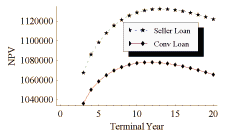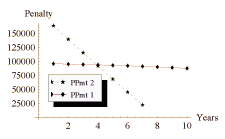The Private Lender
 The negotiation of a sale using seller financing introduces the opportunity to capture profits that would otherwise go to a third party lender. Such a transaction requires the use of sophisticated security instruments and the estimation of before- and after-tax investment benefits accruing to each side of the transaction.
The negotiation of a sale using seller financing introduces the opportunity to capture profits that would otherwise go to a third party lender. Such a transaction requires the use of sophisticated security instruments and the estimation of before- and after-tax investment benefits accruing to each side of the transaction.
The allocation of the "saved" financing costs can be contentious. Assuming the parties can reach agreement, the buyer may obtain a lower interest rate from the seller in return for paying a slightly higher price equal to the financing cost savings. The seller obtains, perhaps enhanced by the use of a prepayment penalty or lock-in clause, tax deferral during the time the loan is outstanding.
 The graphic above depicts just such a situation by showing how the buyer's NPV under the seller's financing dominates conventional financing. The graphic on the right shows two forms of prepayment penalty, PPmt 2 is based on a percentage of the entire remaining balance; PPmt 1 is based on six month's interest calculated on a fraction of the amount prepaid.
The graphic above depicts just such a situation by showing how the buyer's NPV under the seller's financing dominates conventional financing. The graphic on the right shows two forms of prepayment penalty, PPmt 2 is based on a percentage of the entire remaining balance; PPmt 1 is based on six month's interest calculated on a fraction of the amount prepaid.
The sharp real estate investor is in a position to balance these competing interests to determine where optimization lies for each party. The proper calculation of costs and benefits of this sort of arrangement is crucial to the tax and investment planning of each party.
